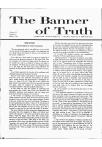ISRAEL GIVEN ANCIENT RELIC OF KING UZZIAH
Stone Slab Marked Site of Bones
A thin slab of limestone barely a foot square has been installed in the place of honor in Jerusalem’s new museum.
It bears eight carved words in Aramaic, an ancient form of Hebrew, which proclaim:
Hither were brought
the bones of Uzziah,
King of Judea.
Not be be opened
The museum paid $250,000 to the Russian Orthodox church for the stone but even that great sum is considered merely a token for a relic that can only be priceless.
Warning Against Arrogance
The slab is more than a tombstone. It is a reminder to people and their rulers of the perils of arrogance.
Uzziah’s story is told in chapter 26 of the Second Chronicles in the Old Testament. He became king of Judea at 16 and reigned 52 years.
In the beginning, Uzziah “did that which was right in the sight of the Lord, and God made him to prosper.”
Fortified Jerusealem
Uzziah built cities, fortified Jerusalem, raised towers in the desert, dug many wells, fostered husbandry of cattle and vineyards, the Bible says.
He assembled a host of fighting men, warred against the Philistines, broke down enemy walls, made engines to shoot arrows and great stones.
His name spread far abroard, even to Egypt, the story continues.
God helped him marvellously until he became strong. But when he was strong, the king became arrogant. One holy day he strode into the temple to burn incense, a rite reserved for the high priest. Four valiant priests followed him and told him he was transgressing. The king became wrathful but as he took up the incense burner leprosy “rose up to his forehead.”
From then until his death, he lived apart, a leper, his son ruling for him. He was buried in the royal garden with the leper’s warning that his bones remain isolated so as not infect survivors.
In 1931, Prof. E.L. Sukenik of the Hebrew university here found the tablet in the Russion Orthodox Eleona convent on the Mount of Olives. It apparently had been there at least a century. British and American biblical scholars authenticated it.
The convent was at that time in British Palestine. In 1948, after the division of Palestine and the departure of the British, the Mount of Olives became part of the Arab moslem kingdom of Jordan.
Took Stone to N.Y.
In 1962, the leader of the Russian Orthodox church abroad, Archimandrite Anthony Grabbe, came here from New York on a visit. He feared that Moslem fanatics might destroy the stone so he carried it to New York in a handbag as personal luggage.
The six day war last year brought the Mount of Olives under Israeli control. Three months ago Father Anthony was appointed head of the Russian ecclesiastical mission here. He thought the stone’s proper place was in Jerusalem and offered it to the museum.
Mayor Teddy Koliek, who had known Father Anthony for some time, started negotiations that ended last Friday in the stone’s return to Jerusalem for the glorification of the reunited city and the edification of mankind.
Deze tekst is geautomatiseerd gemaakt en kan nog fouten bevatten. Digibron werkt
voortdurend aan correctie. Klik voor het origineel door naar de pdf. Voor opmerkingen,
vragen, informatie: contact.
Op Digibron -en alle daarin opgenomen content- is het databankrecht van toepassing.
Gebruiksvoorwaarden. Data protection law applies to Digibron and the content of this
database. Terms of use.
Bekijk de hele uitgave van zaterdag 1 maart 1969
The Banner of Truth | 20 Pagina's

Bekijk de hele uitgave van zaterdag 1 maart 1969
The Banner of Truth | 20 Pagina's


